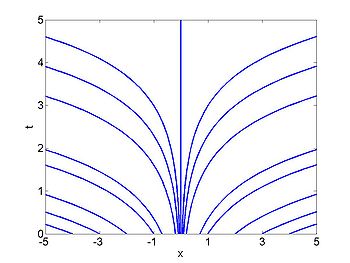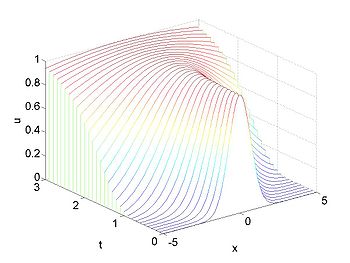Difference between revisions of "Method of Characteristics for Linear Equations"
(→Part 1) |
|||
| (9 intermediate revisions by 3 users not shown) | |||
| Line 17: | Line 17: | ||
<center> | <center> | ||
<math> | <math> | ||
| − | \partial_t u + \partial_x u = 0,\,\,-\infty<x<\infty,\,\,t>0, | + | \partial_t u + \partial_x u = 0,\,\,-\infty < x < \infty,\,\,t>0, |
</math></center> | </math></center> | ||
subject to the initial conditions | subject to the initial conditions | ||
| Line 28: | Line 28: | ||
<center> | <center> | ||
<math> | <math> | ||
| − | \frac{d }{d t} u(X(t),t) = \partial_t u + \frac{d X}{ | + | \frac{\mathrm{d} }{\mathrm{d} t} u(X(t),t) = \partial_t u + \frac{\mathrm{d} X}{\mathrm{d}t}\partial_x u = \partial_x u \left(\frac{\mathrm{d} X}{\mathrm{d}t} - 1 \right) |
</math></center> | </math></center> | ||
| − | Therefore along the curve <math>\frac{d X}{ | + | Therefore along the curve <math>\frac{\mathrm{d} X}{\mathrm{d}t} = 1</math> <math>u(x,t)</math> must be a constant. |
These are nothing but the straight lines <math>x = t+c</math> | These are nothing but the straight lines <math>x = t+c</math> | ||
This means that we have | This means that we have | ||
| Line 45: | Line 45: | ||
<center> | <center> | ||
<math> | <math> | ||
| − | \partial_t u + a(x,t)\partial_x u = 0,\,\,-\infty<x<\infty,\,\,t>0, | + | \partial_t u + a(x,t)\partial_x u = 0,\,\,-\infty < x < \infty,\,\,t>0, |
</math></center> | </math></center> | ||
then we can apply the method of characteristics. | then we can apply the method of characteristics. | ||
| Line 51: | Line 51: | ||
<center> | <center> | ||
<math> | <math> | ||
| − | \frac{d | + | \frac{\mathrm{d} }{\mathrm{d} t} u(X(t),t) = \partial_t u + \frac{\mathrm{d} X}{\mathrm{d}t}\partial_x u = \partial_x u \left(\frac{\mathrm{d} X}{\mathrm{d}t} - a(x,t) \right). |
</math> | </math> | ||
</center> | </center> | ||
| Line 57: | Line 57: | ||
<center> | <center> | ||
<math> | <math> | ||
| − | \frac{d X}{d t} = a(x,t) . | + | \frac{\mathrm{d} X}{\mathrm{d} t} = a(x,t) . |
</math> | </math> | ||
</center> | </center> | ||
| Line 67: | Line 67: | ||
<center> | <center> | ||
<math> | <math> | ||
| − | \partial_t u + x \partial_x u = 0,\,\,-\infty<x<\infty,\,\,t>0, | + | \partial_t u + x \partial_x u = 0,\,\,-\infty < x < \infty,\,\,t>0, |
</math></center> | </math></center> | ||
subject to the initial conditions | subject to the initial conditions | ||
| Line 78: | Line 78: | ||
<center> | <center> | ||
<math> | <math> | ||
| − | \frac{d | + | \frac{\mathrm{d} }{\mathrm{d} t} u(X(t),t) = \partial_t u + \frac{\mathrm{d}X}{\mathrm{d}t}\partial_x u = \partial_x u \left(\frac{\mathrm{d} X}{\mathrm{d}t} - x \right) |
</math></center> | </math></center> | ||
| − | Therefore along the curve <math>\frac{d X}{ | + | Therefore along the curve <math>\frac{\mathrm{d} X}{\mathrm{d}t} = x</math> <math>u(x,t)</math> must be a constant. |
These are the curves <math>x = ce^t</math> | These are the curves <math>x = ce^t</math> | ||
This means that we have | This means that we have | ||
| Line 97: | Line 97: | ||
<center> | <center> | ||
<math> | <math> | ||
| − | \partial_t u + t \partial_x u = 0,\,\,-\infty<x<\infty,\,\,t>0, | + | \partial_t u + t \partial_x u = 0,\,\,-\infty < x < \infty,\,\,t>0, |
</math></center> | </math></center> | ||
subject to the initial conditions | subject to the initial conditions | ||
| Line 108: | Line 108: | ||
<center> | <center> | ||
<math> | <math> | ||
| − | \frac{d | + | \frac{\mathrm{d} }{\mathrm{d} t} u(X(t),t) = \partial_t u + \frac{\mathrm{d} X}{\mathrm{d}t}\partial_x u = \partial_x u \left(\frac{\mathrm{d} X}{\mathrm{d}t} - t \right) |
</math></center> | </math></center> | ||
| − | Therefore along the curve <math>\frac{d X}{ | + | Therefore along the curve <math>\frac{\mathrm{d} X}{\mathrm{d}t} = t</math> <math>u(x,t)</math> must be a constant. |
These are the curves <math>x = t^2/2+c</math> | These are the curves <math>x = t^2/2+c</math> | ||
This means that we have | This means that we have | ||
| Line 126: | Line 126: | ||
<center> | <center> | ||
<math> | <math> | ||
| − | \partial_t u + t \partial_x u = xt,\,\,-\infty<x<\infty,\,\,t>0, | + | \partial_t u + t \partial_x u = xt,\,\,-\infty < x < \infty,\,\,t>0, |
</math></center> | </math></center> | ||
subject to the initial conditions | subject to the initial conditions | ||
| Line 137: | Line 137: | ||
<center> | <center> | ||
<math> | <math> | ||
| − | \frac{d | + | \frac{\mathrm{d} u}{\mathrm{d} t} = \partial_t u + \frac{\mathrm{d} X}{\mathrm{d}t}\partial_x u = \partial_x u \left(\frac{\mathrm{d}X}{\mathrm{d}t} - t \right) + xt |
</math></center> | </math></center> | ||
| − | Therefore along the curve <math>\frac{d X}{ | + | Therefore along the curve <math>\frac{\mathrm{d} X}{\mathrm{d}t} = t</math> which are the curves <math>x = t^2/2+c</math> |
<center> | <center> | ||
<math> | <math> | ||
| − | \frac{d}{ | + | \frac{\mathrm{d}}{\mathrm{d}t}u(x,t) = xt = t^3/2 + c t |
</math> | </math> | ||
| + | |||
| + | |||
</center> | </center> | ||
Therefore | Therefore | ||
| Line 160: | Line 162: | ||
Therefore the solution is given <math>u(x,t) = t^4/8 + (x -t^2/2) t^2/2 + f(x-t^2/2)\,</math> or | Therefore the solution is given <math>u(x,t) = t^4/8 + (x -t^2/2) t^2/2 + f(x-t^2/2)\,</math> or | ||
<math>u(x,t) = -t^4/8 + x t^2/2 + f(x-t^2/2)\,</math> | <math>u(x,t) = -t^4/8 + x t^2/2 + f(x-t^2/2)\,</math> | ||
| + | |||
| + | == Lecture Videos == | ||
| + | |||
| + | === Part 1 === | ||
| + | |||
| + | {{#ev:youtube|zXEvCJyHQSg}} | ||
| + | |||
| + | === Part 2 === | ||
| + | |||
| + | {{#ev:youtube|vRRVU4VrxV0}} | ||
| + | |||
| + | === Part 3 === | ||
| + | |||
| + | {{#ev:youtube|xkGdvFGit_c}} | ||
| + | |||
| + | |||
| + | === Part 4 === | ||
| + | |||
| + | {{#ev:youtube|rW-voMoG0KI}} | ||
Latest revision as of 05:25, 7 August 2020
| Nonlinear PDE's Course | |
|---|---|
| Current Topic | Method of Characteristics for Linear Equations |
| Next Topic | Traffic Waves |
| Previous Topic | |
We present here a brief account of the method of characteristic for linear waves.
Introduction
The method of characteristics is an important method for hyperbolic PDE's which applies to both linear and nonlinear equations.
We begin with the simplest wave equation
subject to the initial conditions
We consider the solution along the curve [math]\displaystyle{ (x,t) = (X(t),t) }[/math]. We then have
Therefore along the curve [math]\displaystyle{ \frac{\mathrm{d} X}{\mathrm{d}t} = 1 }[/math] [math]\displaystyle{ u(x,t) }[/math] must be a constant. These are nothing but the straight lines [math]\displaystyle{ x = t+c }[/math] This means that we have
Therefore the solution is [math]\displaystyle{ u(x,t) = f(x-t)\, }[/math].
General Form
If we consider the equation
then we can apply the method of characteristics. We consider the solution along the curve [math]\displaystyle{ (x,t) = (X(t),t) }[/math]. We then have
[math]\displaystyle{ \frac{\mathrm{d} }{\mathrm{d} t} u(X(t),t) = \partial_t u + \frac{\mathrm{d} X}{\mathrm{d}t}\partial_x u = \partial_x u \left(\frac{\mathrm{d} X}{\mathrm{d}t} - a(x,t) \right). }[/math]
This gives us the following o.d.e. for the characteristic curves (along which the solution is a constant)
[math]\displaystyle{ \frac{\mathrm{d} X}{\mathrm{d} t} = a(x,t) . }[/math]
Example 1
Consider the equation
subject to the initial conditions
We consider the solution along the curve [math]\displaystyle{ (x,t) = (X(t),t) }[/math]. We then have
Therefore along the curve [math]\displaystyle{ \frac{\mathrm{d} X}{\mathrm{d}t} = x }[/math] [math]\displaystyle{ u(x,t) }[/math] must be a constant. These are the curves [math]\displaystyle{ x = ce^t }[/math] This means that we have
Therefore the solution is given [math]\displaystyle{ u(x,t) = f(xe^{-t})\, }[/math].
Example 2
Consider the equation
subject to the initial conditions
We consider the solution along the curve [math]\displaystyle{ (x,t) = (X(t),t) }[/math]. We then have
Therefore along the curve [math]\displaystyle{ \frac{\mathrm{d} X}{\mathrm{d}t} = t }[/math] [math]\displaystyle{ u(x,t) }[/math] must be a constant. These are the curves [math]\displaystyle{ x = t^2/2+c }[/math] This means that we have
Therefore the solution is given [math]\displaystyle{ u(x,t) = f(x - t^2/2)\, }[/math].
Non-homogeneous Example
We can also use the method of characteristics in the non-homogeneous case. We show this through an example Consider the equation
subject to the initial conditions
We consider the solution along the curve [math]\displaystyle{ (x,t) = (X(t),t) }[/math]. We then have
Therefore along the curve [math]\displaystyle{ \frac{\mathrm{d} X}{\mathrm{d}t} = t }[/math] which are the curves [math]\displaystyle{ x = t^2/2+c }[/math]
[math]\displaystyle{ \frac{\mathrm{d}}{\mathrm{d}t}u(x,t) = xt = t^3/2 + c t }[/math]
Therefore
[math]\displaystyle{ u(t^2/2+c,t) = t^4/8 + c t^2/2 + c_2\, }[/math]
Now
Therefore the solution is given [math]\displaystyle{ u(x,t) = t^4/8 + (x -t^2/2) t^2/2 + f(x-t^2/2)\, }[/math] or [math]\displaystyle{ u(x,t) = -t^4/8 + x t^2/2 + f(x-t^2/2)\, }[/math]
Lecture Videos
Part 1
Part 2
Part 3

